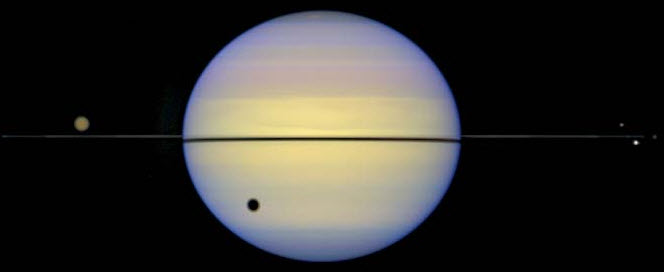Saturn
539-551
Through even a small telescope Saturn is an amazing sight! The rings that surround the planet stand out brightly and seem oddly out of place. Even to a experienced observer, the rings still elicit a sense of wonder. As "unlikely" as they appear, however, rings are one of the common characteristics of the outer planets. But Saturn does have its own personality which includes the amazing fact that its average density is just a bit less than the density of water. You could "float" Saturn in a (BIG) bathtub!
Basic Facts
Figure 18.12 is an actual composite of 165 images taken by the Cassini spacecraft in 2006 as it circled the planet. The Cassini satellite was originally designed to finish its study of Saturn in 2006 but the spacecraft continues to function very well and the Cassini mission has been extended to 2017! The Cassinin-Huygens mission is a cooperative project of NASA, the European Space Agency and the Italian Space Agency. |
||||||||||||||||||||
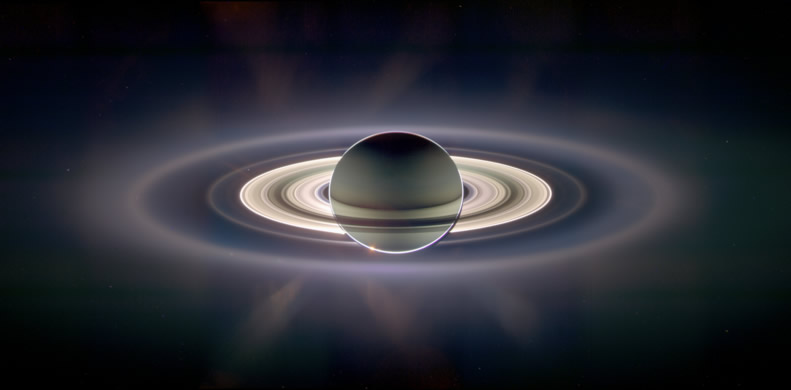 |
||||||||||||||||||||
| Figure 18.12 Cassini image of Saturn and its ring system. Click on image to open a pop-up window bigger view. (Image courtesy NASA and CICLOPS) | ||||||||||||||||||||
The Interior and Atmosphere
Saturn has the lowest density of all the planets and is also the most oblate. This suggests that Saturn is essentially liquid, composed mostly of hydrogen and helium with a small solid core. Saturn has a lower mass than Jupiter and hence lacks the internal pressure to create as extensive a region of metallic hydrogen. For this reason, Saturn's magnetic field is about 20 times weaker than Jupiter's magnetic field. Despite this Saturn does have a magnetosphere and aurora have also been observed in Saturn's atmosphere.Example 18.4 Use the following image to estimate the oblateness of Saturn.
Solution: Use the rollover image shown below and the definition of oblateness

Hubble image from April 1996 (Image courtesy HSTScI & NASA) |
Example 18.5 Estimate the average density of Saturn and argue that this implies that the structure of Saturn is much different than that of Jupiter.
Solution: Use the following fate from Table 18.3:
- MSaturn = 5.69 x 1026 kg
- RSaturn = 6.50 x 104 km = 6.5 x 107 m
SInce density = Mass/Volume it follows that
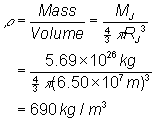
Saturn has a very low density! This is less than the density of water and about one-half the density of Jupiter. This implies that Saturn likely lacks as extensive a metallic-hydrogen interior as does Jupiter..
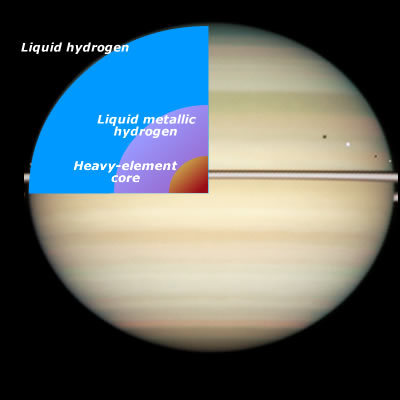 |
Saturn's atmosphere is very similar to Jupiter's and consists of almost entirely Hydrogen (90% by weight) and Helium (10% by weight) with traces of heavier gases. This is very similar to what was believed to be the composition of the Solar Nebula. Figure 18.13 shows a profile for the interior of Saturn. As is the case with Jupiter, Saturn is essentially a liquid planet. |
| Figure 18.13 The internal profile of Saturn. |
Saturn's Ring and Moons
What are Saturn's rings made of? Astronomers have known for more than a century that the rings cannot be solid - they must consist of small particles orbiting the planet. We have also learned from numerous flyby missions that Saturn's many moons (more than 50) play a critical role in the ring system.
Figure 18.14 shows an artist's conception of the rings. You could literally "swim" through the rings. They would appear a swarm pf icy-snowballs measuring from a few metres across to tiny, pebbles. They are all orbiting around Saturn and since they all have essentially the same velocity relative to the planet any bumping between the ring particles would be gentle. Part of the evidence that Saturn's rings are not solid is that we can see through them and at various times during its orbit around the Saturn Saturn's rings appear edge-on to us. When this happens they can disappear from view for several weeks. This tells us that the rings are thin - only a few kilometers thick. Other evidence however comes from the position of the rings themselves. |
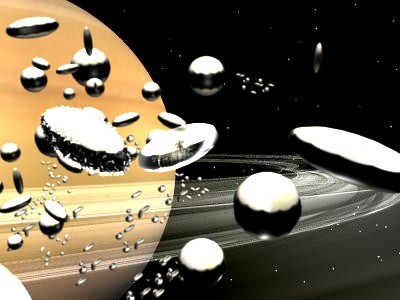 |
| Figure 18.14 An artist's conception of the Saturnian ring system (image courtesy of author) |
The rings are so close to the planet that the tidal forces on a solid ring or even moon would quickly tear the ring apart. This is because the gravitational tug on the inside of the ring would be much greater than the gravitational tug on the outside of the ring. You have encountered tides in may places and may recall that the same process is what distorts the shapes of close binary stars and even leads to the mass transfer from stars (the "Algol paradox" and Type 1 supernovae are examples.). The Roche Limit is defined as the closest point one body can orbit around another before it is tidally disrupted. The Roche limit for Saturn is approximately 2.5 planetary radii or about 160 000 km from the centre of the planet. Figure 18.14 shows the Roche limit on an image of Saturn and its rings.
 |
| Figure 18.14 The Roche tidal limit and Saturn's ring system. |
Saturn's ring system is complex. Figure 18.15 shows the rings divided into a series of concentric bands.
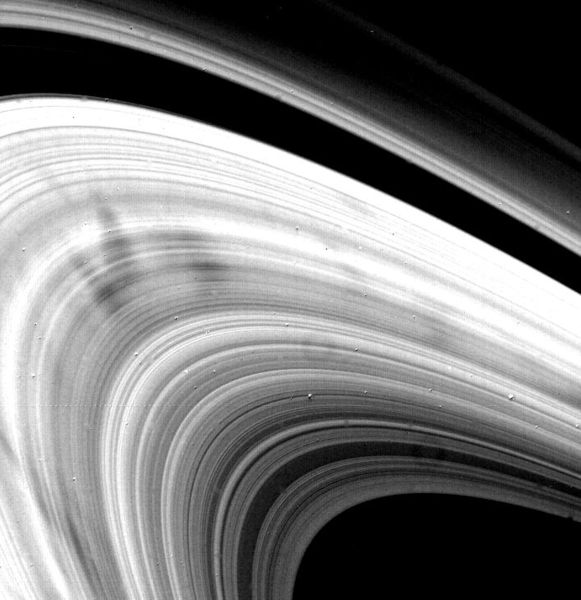 |
The numerous thin bands are the combined effects of Saturn's many smaller moons that help "shepherd" the ring material in to the patterns that we see. What is unusual in Figure 18.15 is the dark "smudges' that radiate across the rings. Most of Saturn's moon are small, icy worlds and many of them are most likely objects that have been captured by Saturn later in its history. As well, most of these moons are in tidally locked orbits around the planet. |
| Figure 18.15 Close-up image of Saturn's ring system as seen by the Voyageur spacecraft in August 1981. (Image courtesy NASA) |
The Good Shepherds!
| As you will see in future sections, planetary rings are common and are maintained and shaped by the gravitational interaction with small, shepherding moons. Figure 18.15a shows the affect of the two shepherd moons Prometheus and Pandora as they help maintain and shape the F-ring roud Saturn. | |
| Figure 18.15a |
Titan and Enceladus
Although most of its moons are small, Saturn does have several large-sized satellites. The largest of these moons is Titan.
On December 13, 2004 a silvery-white balloon bearing the Huygens lander entered Titan's thick, Nitrogen rich atmosphere and descended safely to a region on the moon's surface named Xanadu. Titan's wind swept surface is strangely familiar with sand dunes and other land forms similar to those that form on Earth. Figure 18.16 shows a Cassini image of Titan's atmosphere and Figure 18.17 shows the surface of Titan as imaged by the Huygens probe
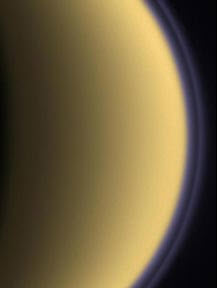 |
Titan's atmosphere consists of almost 90% nitrogen with smaller amounts of methane, ethane and other organic molecules. The very low temperature of Titan means that methane rain occurs and there are likely methane seas on the surface! At ground level the atmospheric pressure on Titan is greater than it is on Earth. Titan's density suggests that is quite different structurally than Saturn and likely has an extensive, silicate core. The applet in Figure 18.18 provides a view of Titan. |
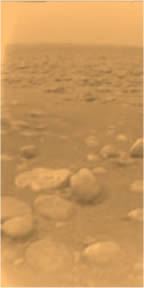 |
| Figure 18.16 Cassini image of Titan's atmosphere (image courtesy NASA) | Figure 18.17 The surface of Titan (Image courtesy NASA/CICLOPS) |
| Enceladus is another Saturn's major moons. Figure 18.19 is a remarkable Cassini image of Enceladus taken by the Cassini orbiter. The surface is remarkably free of craters! This suggests that the surface of the moon is continually being "flooded" much as you would a skating rink in the winter months. What is flooding the surface? There is very good evidence that there is a layer of liquid water only a few meters below the surface of this icy world! | |
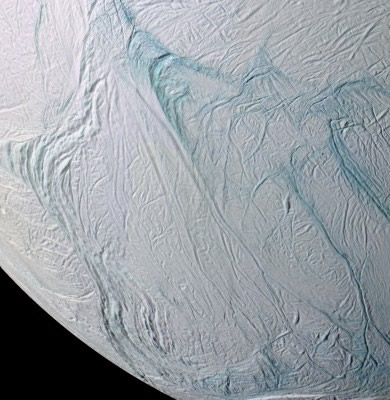 |
|
| Figure 18.19 The surface of Enceladus (image courtesy Cassini IMaging Team/NASA) | Figure 18.18 |
Example 18.6 Infrared observations reveal that the polar regions of Enceladus are abnormally warm with water/ice geysers actively venting into the moons atmosphere. What could account for the energy source for this moon?
Solution: The energy source is most likely due to tidal stretching. This is the same process that makes Jupiter's moon Io such a hot, volcanic environment. Enceldaus is close enough to Saturn that it is tidally locked in its orbit. INteraction with other moons gives the orbit of Enceladus a small eccentricity so there will be some stretching as it orbits the planet.
Practice
- Why does presence of aurora in Saturn's upper atmosphere suggest that it has an inner layer of metallic hydrogen?
- Why do we believe that Enceladus is geologically active?
- Why can't Saturn's rings be a solid, thin plate orbiting the planet?
- The moon Enceladus has an albedo of 0.99. What does this mean and speculate on what this tells us about the surface of the moon.
- Why do you think the outer planets have rings but not the Terrestrial planets?
- What are shepherd moons?

To understand Saturn as an Outer Solar System planet
Chp 23-4,5
![]()

Remember - densities can be expressed in grams per cubic cm (g/cm3) or in kilograms per cubic metre (kg/m3). To vonvert gtom g/cm3 to kg/m3 multiply buy 1000.
For example, the density of water is 1 g/cm3 or 1000 kg/m3.
